

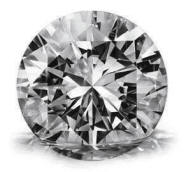 Cash spends better than a diamond sitting in a jewelry box! So sell your diamonds today! Cash spends better than a diamond sitting in a jewelry box! So sell your diamonds today!

Jewels We Buy has some of the most knowledgeable and qualified appraisers
who strive to offer you the highest and most fair prices
for diamonds and precious stones. Each diamond and precious stone is accurately graded for clarity, color, cut and carat weight according to GIA standards. Jewels We Buy is renowned for serving the wholesale marketplace with clients worldwide
striving to pay you, our client, the highest possible price.
Diamonds do not have to be removed from settings for grading and appraisal. Grading is accomplished with state-of-the-art instruments designed to appraise diamonds without removal.
Also, please do not hesitate to send broken or chipped diamonds as we are fully capable to repair them for resale.

We buy precious stones, loose or mounted. We are current on precious stone values.
The annual Tucson Gem & Jewelry Show in February is 2 weeks of constant pricing. Working elbow to elbow with buyers from TV shopping channels to dealing with importers & cutters from around the world, example in 2006 I bought nice quality Aqua for 35.00 per ct the next year the price jumped to 70.00 .You may have a Tanzanite, Emerald, Aqua, Opal or some other type of other precious gemstone that could be worth 10 times what you paid.

To identify the factors that determine the value of a diamond in order of their importance, we list them as follows:
- Body color (color grade)
- Internal characteristics (clarity grade)
- Cut and proportion (often referred to as the "make")
- Carat weight
Each factor is a lesson in itself, and so we have devoted some basic information on each.

When we discuss body color we are referring to how much yellow or brown tint is observable in the diamond.

The color designation frequently used to grade an absolutely colorless diamond is the letter D. This letter designation is part of a color-grading system introduced by the GIA and is used extensively in the diamond trade. The GIA classification progresses from D, the finest classification on this scale (colorless), through the alphabet to Z, getting progressively more yellow or brown. The grades, D, E, F are exceptionally fine and are the only grades that should be referred to as colorless.

For the average consumer, the colors D, E and F can all be grouped as very fine and may be referred to as "colorless," "gem," or "gem white," as they are often described by diamond dealers; G and H may be referred to as "fine white." This does not mean, however, that diamonds having color grades less fine than I aren't beautiful or desirable. They can make beautiful, highly desirable jewelry.
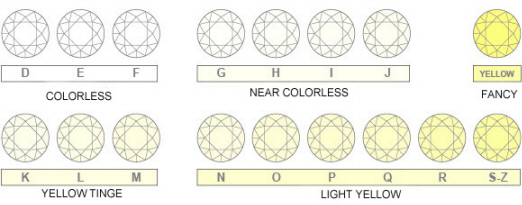

To an untrained eye, discerning the difference in color from D down to H in a mounted stone - without direct comparison - is almost impossible. Nevertheless, the difference in color greatly affects the value of the diamond.
This sounds complicated, but the range of color will become clear to you the moment you begin looking at diamonds. It is our intention to inform you of the variations so that you will be watchful when you sell your diamonds.

There are basically two types of flaws: internal flaws or inclusions; and external flaws or blemishes. Among these two categories are any number of flaws. We will discuss those flaws here, so that you have a working vocabulary of diamond imperfections.


Pinpoint - This is a small, usually whitish (although it can be dark) dot that is difficult to see. A group of pinpoints is simply a cluster of pinpoint flaws, and cannot be classified as VVS. A cloud of pinpoints is hazy and is not easily seen.
Dark spot - This may be a small crystal inclusion or a thin, flat inclusion that reflects light like a mirror. It may also appear as a silvery, metallic reflector.
Colorless crystal - This is often a small crystal of diamond, although it may be another mineral. Sometimes it appears very small, sometimes large enough to substantially lower the flaw grade to SI2 or even I1. A small group of colorless crystals lowers the grade from possible VS2 to I3.
Feather - This is another name for a crack. A feather is not dangerous if it is small and does not break out through a facet. Thermoshock or ultrasonic cleaners can make it larger.
Growth or grain lines - These can be seen only when examining the diamond while slowly rotating it. They appear and disappear usually instantaneously. They will appear in a group of two, three, or four pale brown lines. If they cannot be seen from the crown side of the diamond and are small, they will not affect the grade adversely.
Laser treatment - Used today to make flaws less visible, this improves the stone aesthetically. For example, a black spot can be "vaporized" and will practically disappear. However, the laser holes can be seen with a 10x loupe, looking like fine straight white threads.

A small natural - These usually occur on the girdle and look like a rough, unpolished area. They appear to be scratch lines or small triangles called trigons. Often naturals, are polished and resemble an extra facet, especially if they occur below the girdle edge. A natural is a remnant of the original skin of the diamond, and is often left on the girdle showing that the cutter tried to cut the largest possible diameter from the rough.
Nick - This is a small chip, usually on the girdle, and can be caused by wear, especially if the girdle has been proportioned on the thin side. Sometimes a nick or chip can be seen on the edge of the facets where they meet. If small, the bruised corner can be polished, creating an extra facet. This usually occurs on the crown.
Girdle roughness - This blemish appears as crisscrossed lines, brighter and duller finishing, and minute chipping. This can be remedied by faceting or repolishing.
Pits or cavities - Pits or holes on the table facet, especially if they are deep, will quickly lower the grade of the stone. Removing pits involves recutting the whole top of the stone, and can also shrink the stone's diameter.
Scratch - A scratch is usually a minor defect that can be removed with simple repolishing. Remember, however, that in order to repolish the stone, it must be removed from its setting, and then reset after it has been polished.
Polishing lines - Many diamonds exhibit polishing lines. If they appear on the pavilion side and are not too obvious, they do not lower the value. In some small diamonds these scratch lines can be obvious, and are usually the result of a badly maintained polishing wheel.
Abraded or rough culet - The culet has been chipped or poorly finished. This is usually a minor flaw.

The cut of a diamond and the proportioning of the cut - the make - are of extraordinary importance, because they have the greatest influence on the fire (variety and intensity of rainbow colors seen) and brilliance (liveliness or sparkle) of the stone.

We will discuss cut and proportion of the round brilliant cut stone, since this is the most popular cut. It usually displays the stone's qualities to their greatest potential, and is therefore the best "investment" cut.
The following diagram provides an illustration, in its simplest terms, of the effect of cut and proportion on fire and brilliance in a round brilliant-cut stone. Many times we will send a stone to be recut.


Excellently cut and proportioned stones cost significantly more per carat than those that are not cut well. The following will give a very basic idea of the monetary effect of some of the most frequently encountered defects in cut and proportion.
- Table is not a reasonably accurate octagon: 2% - 15% off
- Girdle is too thick: 5% - 20% off
- Symmetry of crown facets off: 5% - 15% on round, less on fancy cuts since defect is not so easily seen
- Asymmetrical culet: 2% - 5% off
- Misaligned culet: 5% - 25% off
- Stone too shallow: 15% - 20% off
- Stone too thick: 10% - 30% off
- Slightly thin crown: 5% - 20% off
- Slightly thick crown: 5% - 15% off
As you can see, there is a fairly wide range here, depending upon the severity of the error, and only an experienced professional can determine the extent to which the value of a given stone may be lessened. But a quick computation can show that a stone which suffers from several errors (which is fairly common) could certainly have its price per carat significantly reduced.

Diamonds of the finest quality are sold for the highest price per carat and diamonds of progressively less fine quality are sold for a progressively lower price per carat.
As a rule, there is an increase in the price per carat as we go from smaller to larger stones, since the larger stones are more and more limited in supply. For example, stones of the same quality weighing 1/2 carat will sell for more per carat than stones weighing 1/3 carat; stones weighing 3/4 carat will sell for more per carat than stones of the same quality weighing 1/2 carat. And stones of the same quality weighing 1 carat will sell for much more than stones weighing 90 to 96 points. (There are 100 points to a carat.)

The Gemological Institute of America or GIA is the only industry accepted standard for an unbiased quality grade of a diamond. With a GIA certificate, a diamond can be sold from dealer to dealer on face value, without the need of a second opinion. GIA does not value or appraise a diamond. Any other 3rd party appraisal is typically used as a marketing tool by a retail jeweler, and does not carry the weight or integrity of a GIA certificate. Typically, a 3rd party appraisal has an inflated valuation that is way above retail, as well as an inflated grade of clarity and color. An appraisal or grade that is established by a retail jeweler, even if the person grading the diamond has been trained by the GIA and is a Graduate Gemologist (GIA), is not the same as a GIA certificate.
You are invited to obtain your own GIA report in advance of selling your stone. Your stone must be delivered unset to GIA. The New York office only accepts stones that are .70 carats or larger. The California office will accept smaller size diamonds. We have provided their contract information for your convenience. Or you may have our GIA Graduate Gemologist evaluate your diamond.
SELL YOUR DIAMONDS & PRECIOUS STONES
& GET CASH NOW!

|

Call TODAY!
Toll Free 1-888-785-3030

-
DIAMOND SOLITARES (engagement rings, anniversary bands)
-
CERTIFIED DIAMONDS BRING HIGHER PRICES (GIA, EGL,IGI & AGS)
-
OLD CUT& EUROPEAN (CHIPED ,BROKEN OR NOT)
-
FANCY SHAPES ( pear ,princess, oval ,marquise, trillion hearts and emerald cut)
-
FANCIES( light fancy yellow& canary)
-
DIAMOND STUDS ½ CT AND LARGER( premiums prices for 2.0ct and larger
-
DIAMOND TENNIS BRACELETS ( better quality a must ,nothing under 2cts please)
-
DIAMOND NECKLACES
-
RUBY( better quality only)
-
EMERALD(medium to grass green)
-
SAPPHIRE(all colors yellow, green, pink etc.)
-
TANZANITE (blue zoisite)
-
OPAL (black precious only)
-
TSAVORITE(green garnet)
-
And Many More!

Obviously this is the single most important question when you are considering selling a piece of diamond jewelry. The value of a diamond is primarily determined by its 4C's:
CARAT: how much does the diamond weigh?
COLOR: does the diamond look yellow?
CLARITY: can you see any 'stuff' in the diamond?
CUT: how well does a diamond reflect light?
Once these four factors are known, we can determine how much your diamond is worth. To make this process as quick as possible we have come up with the diamond price quote system that will enable us to quickly place a value on your diamond.
You are under no obligation to sell us your diamond, and the quote is free. Try our diamond price quote now.

-
Have been clarity enhanced (CE)
-
Laser drilled
-
Artificially color treated
-
Are of SI3, I1, I2 or I3 clarity
-
Contain black eye visible inclusions
Identifying The Cut |
Emerald cut: Rectangular or square step cut with diagonally cut corners and two, three, or four rows of facets parallel to the girdle on the crown and pavilion. It is frequently used to fashion emeralds. If the shape is square, it is called a square emerald cut.
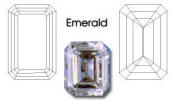 |
Pear: Variation of the brilliant cut with a pear-shaped girdle outline and 56 to 58 facets. Also called pendeloque or teardrop.
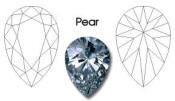 |
Heart: Modified brilliant cut in the shape of a heart, with a table, 32 crown facets, 24 pavilion facets, and a shield-shaped culet.
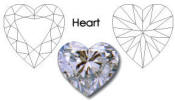 |
Marquise: Elongated, boat-shaped brilliant cut with curving sides and pointed ends, developed in France in the 1740s. Believed to have been named after the Marquise de Pompadour, a mistress of King Louis XV. Also called navette.
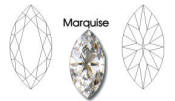 |
Oval: Brilliant cut with an elliptical girdle outline; also called an oval brilliant cut. Obsolete barrel-shaped cut, circular in section and covered with triangular facets.
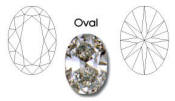 |
Princess: popular square or rectangular modified brilliant cut usually with 57 facets (21 crown facets, 32 pavilion facets, and four girdle facets) but occasionally a rectangular or square brilliant with 144 facets. Many variations are on the market.
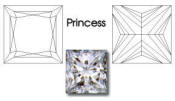 |

Call TODAY!
Toll Free 1-888-785-3030
|

















